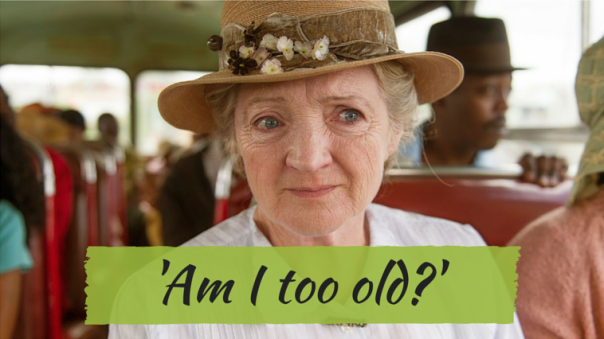 Julia McKenzie as Agatha Christie’s Miss Marple
Julia McKenzie as Agatha Christie’s Miss Marple
We have books for children, young adults and now new adults. Where are the books for the more mature person? Middle-aged parents and grandparents as supporting characters are abundant in fiction, but human antiques are much more than just their parental status.
Our growing ageing populations in the West are healthier and more robust than those that came before them, leading to longer lifespans. The oldest person to ever live made it to 123 years. A lot can happen between the ages of 40 and 123. We don’t just turn into decrepit bores on our 40th birthdays. Well, most of us don’t.
Publishers have yet to exploit this growing demographic. Since there are no book store or library shelves dedicated to representing a wrinklier audience, finding recommendations is difficult.
Huffpost’s An Ode to Older Charactersin Literature and Goodreads Listopias cover main and gay characters over 40, Books about over 60s and Protagonists over 60. However, when browsing the lists you come to realise most of these novels are classics, written by authors now deceased.
Ageing leading ladies in particular are underrepresented. Goodreads Listopias Female characters over 35 and Amazing older heroines aren’t as well populated as one would hope considering the longest list for both genders was creeping up to 300.
When browsing through the 5 most popular genres you notice certain trends. With romance and erotica you’ve got your standard older hero/younger heroine relationships, contemporary cougar lit and a few couples over 40. Female authors dominate the genre with men taking on feminine pseudonyms to sell their work – a practice usually used by the fairer sex.
Crime, thrillers and mysteries are male-dominated. Seasoned or retired detectives sporting Y chromosomes written by men are abundant. And those seem to outsell ones by women with similarly gendered protagonists, perhaps due to many being consigned to the Cozy Mystery sub-section primarily populated with more senior authoresses and heroines such as Agatha Christie’s Miss Marple and M.C. Beaton’s Agatha Raisin. These days, however, the ladies do seem to be making inroads into the mainstream with the likes of Tana French, Gillian Flynn, Tess Gerritsen and Kathy Reichs.
As always the sci-fi/fantasy section is a dumping ground for everything you can’t easily classify, anything that falls into multiple genres. Sub-genres dystopia, post-apocalyptic, sci-fi romance, paranormal romance, urban fantasy and young adult fantasy possess the most female protagonists and writers. Characters are wise teachers and mentors, stereotypical witches and healers, crones and spinster hags.
Anything you might consider horror written by women you won’t find in the horror section. At least, not anymore. They’ve all been shifted to fantasy, paranormal fantasy and dark romance. A reader might be more than a little shocked at the graphic descriptions of blood and guts in Laurell K. Hamilton’s early Anita Blake books. Personally I’d class them as crime / horror. Despite the fantastical elements of Stephen King’s novels, no matter where you look they are always on the horror shelves.
If it’s spiritual bestselling non-fiction, it’s written by men whether it’s religious or atheist. Unless it focuses exclusively on negatives like polygamist cults. Quite a large chunk of Christian fiction is romance written by women, and the rest is mostly classics like Chaucer’s Canterbury Tales, Dante’s Divine Comedy, Arthur Miller’s The Crucible and C.S. Lewis’s Chronicles of Narnia. I’m not well-versed in this genre so I can’t say for certain what the representation of grey-haired characters is, but I can wager a guess that the gents are winning this one, too. God is male after all. Few religions are modeled on equality or matriarchies. (Gaia, though little known, is the highest ranking female I know in religion and mythology as the Greek Mother Goddess birthing the universe and all the heavenly gods.)
When looking at non-fiction in general, there’s plenty for and about those closing in on the twilight years of life. Memoirs and biographies fly off the shelves at Christmas. Politicians, distinguished academics and historians tend to fall in to the realm of middle age and their books are plentiful. But again, authors of the female variety are few.
In movies there are a growing number of older characters, sometimes whole casts. Red, The Expendables, Last Vegas and The Best Exotic Marigold Hotel are just a few examples. Many of our much loved movie stars are no spring chickens today. Brad Pitt, Meryl Streep, Samuel L. Jackson, Sandra Bullock, Morgan Freeman, Julianne Moore, Tom Cruise, Judi Dench, George Clooney, Jodie Foster and Meg Ryan are all over 50. Genres where you’d expect the actors to be young, such as action, all seem to star actors over 40. Recent movies like Terminator 5, Avengers 2, Furious 7, Spy, Spectre, San Andreas and Ant-Man reflect this. And few female action stars among them. Catherine Bray and Guy Lodge rightly question whether Hollywood is afraid of older women in the Guardian to dubious casting choices.
On the whole, despite there being plenty of older writers, characters of a similar age continue to be underrepresented in fiction as anything other than parental figures, mentors and crime fighters.
There’s a wise older mother (Abigail Adams) in my new book (Arabella). She’s 51; does that count? Her future daughter-in-law LOVES her…
LikeLike